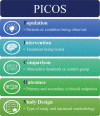Articulating the "So, What?" in Clinical Research: Insight from the M-CHOIR Group
- PMID: 33133904
- PMCID: PMC7572177
- DOI: 10.1097/GOX.0000000000002848
Articulating the "So, What?" in Clinical Research: Insight from the M-CHOIR Group
Abstract
With the academic culture of "publish or perish," authors must ensure that they are delivering high-quality data with a meaningful impact on clinical practice. Even for physician-scientists at the top of their fields, establishing the relevance of a study to clinical practice is a challenge. Thus, it is essential that research proposals ask questions that are clinically important, use appropriate methodologies, and examine outcomes that are relevant to both the physicians and the patients. The question of "so, what?" or in other words, "who cares?" is one that can make or break a study's impact on clinical practice. Researchers should use models such as PICOS (Population, Intervention, Comparison, Outcomes, and Study design) and FINER (Feasible, Interesting, Novel, Ethical, Relevant) and ask why readers will care about their study's findings before the study is conducted. By doing so, researchers can ensure the successful execution of their study and a meaningful impact of their findings, in both academia and clinical practice. This Special Topic article aims to guide researchers in producing relevant, impactful conclusions of their studies by providing input and resources from the Michigan Center for Hand Outcomes and Innovation (M-CHOIR) group.
Copyright © 2020 The Authors. Published by Wolters Kluwer Health, Inc. on behalf of The American Society of Plastic Surgeons.
Conflict of interest statement
Disclosure: Dr. Chung receives funding from the National Institutes of Health and book royalties from Wolters Kluwer and Elsevier. He has received financial support from Axogen to attend conferences. The other authors have no financial interest to declare.
Figures







References
-
- Healy MA, Mullard AJ, Campbell DA, Jr, et al. Hospital and payer costs associated with surgical complications. JAMA Surg. 2016;151:823–830. - PubMed
-
- Vonlanthen R, Slankamenac K, Breitenstein S, et al. The impact of complications on costs of major surgical procedures: a cost analysis of 1200 patients. Ann Surg. 2011;254:907–913. - PubMed
-
- Chalmers I, Glasziou P.Avoidable waste in the production and reporting of research evidence. Lancet. 2009;374:86–89. - PubMed
-
- Loonen MP, Hage JJ, Kon M.Publications of plastic surgery research 1972 through 2004: a longitudinal trend analysis of three international journals. J Plast Reconstr Aesthet Surg. 2007;60:934–945. - PubMed
LinkOut - more resources
Full Text Sources
